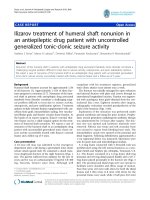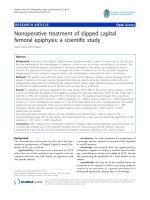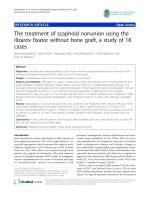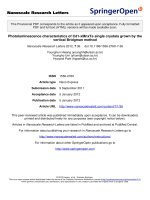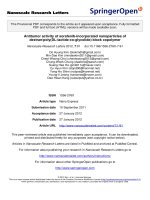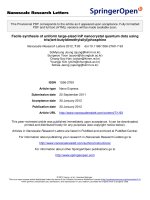Báo cáo toán học: " Successful treatment of severe accidental hypothermia with cardiac arrest for a long time using cardiopulmonary bypass - report of a case" docx
Bạn đang xem bản rút gọn của tài liệu. Xem và tải ngay bản đầy đủ của tài liệu tại đây (430.86 KB, 13 trang )
This Provisional PDF corresponds to the article as it appeared upon acceptance. Fully formatted
PDF and full text (HTML) versions will be made available soon.
Successful treatment of severe accidental hypothermia with cardiac arrest for a
long time using cardiopulmonary bypass - report of a case
International Journal of Emergency Medicine 2012, 5:9 doi:10.1186/1865-1380-5-9
Keigo Sawamoto ()
Katsutoshi Tanno ()
Yoshihiro Takeyama ()
Yasufumi Asai ()
ISSN 1865-1380
Article type Case report
Submission date 16 July 2011
Acceptance date 2 February 2012
Publication date 2 February 2012
Article URL />This peer-reviewed article was published immediately upon acceptance. It can be downloaded,
printed and distributed freely for any purposes (see copyright notice below).
Articles in International Journal of Emergency Medicine are listed in PubMed and archived at
PubMed Central.
For information about publishing your research in International Journal of Emergency Medicine go to
/>For information about other SpringerOpen publications go to
International Journal of
Emergency Medicine
© 2012 Sawamoto et al. ; licensee Springer.
This is an open access article distributed under the terms of the Creative Commons Attribution License ( />which permits unrestricted use, distribution, and reproduction in any medium, provided the original work is properly cited.
Successful treatment of severe accidental hypothermia with cardiac arrest for a long time using
cardiopulmonary bypass – report of a case
Keigo Sawamoto*
1
, Katsutoshi Tanno
1
, Yoshihiro Takeyama
1
, and Yasufumi Asai
1
1
Traumatology and Critical Care Medicine,
Sapporo Medical University, Sapporo, Japan
* Corresponding author:
Email addresses:
KT:
YT:
YA:
Abstract
Accidental hypothermia is defined as an unintentional decrease in body temperature to below 35°C, and
cases in which temperatures drop below 28°C are considered severe and have a high mortality rate. This
study presents the case of a 57-year-old man discovered drifting at sea who was admitted to our hospital
suffering from cardiac arrest. Upon admittance, an electrocardiogram indicated asystole, and the patient’s
temperature was 22°C. Thirty minutes of standard CPR and external rewarming were ineffective in raising
his temperature. However, although he had been in cardiac arrest for nearly 2 h, it was decided to continue
resuscitation, and a cardiopulmonary bypass (CPB) was initiated. CPB was successful in gradually
rewarming the patient and restoring spontaneous circulation. After approximately 1 month of rehabilitation,
the patient was subsequently discharged, displaying no neurological deficits. The successful recovery in this
case suggests that CPB can be considered a useful way to treat severe hypothermia, particularly in those
suffering from cardiac arrest.
Introduction
In the clinical setting, it is often difficult to determine whether hypoxia associated with submersion or severe
accidental hypothermia associated with immersion is the cause of cardiac arrest due to drowning. We here
report the case of a patient who developed prolonged cardiac arrest because of drowning in the sea, a
situation in which one is stumped concerning resuscitation. Using cardiopulmonary bypass (CPB),
resuscitation was achieved, and the patient had no neurological deficits.
Case report
In June 2008, a 57-year-old male was found drifting in the sea at 08:07 a.m. The seawater temperature was
12 °C. Emergency medical technicians confirmed his cardiac arrest at the port at 08:28 a.m., and his
electrocardiogram showed asystole. He was brought to our emergency department (ED) at 08:51 a.m. A core
body temperature of 22.0 °C was registered in the rectum, and his pupils were fixed and dilated (Figure 1).
Although we continued standard CPR with tracheal intubation and external rewarming using warmed
infusions and radiant heat, the patient’s temperature remained at 22.8 °C 30 min after arrival. In addition,
sputum comprising massive bubbles resembling seawater was evident in his endotracheal tube. Because he
had been in cardiac arrest for at least 90 min, we were stumped about whether to continue resuscitation or
not at that time. However, we found that spontaneous slight gasping breathing without a pulse and chest
compressions appeared at 09:24 a.m. We then decided to apply CPB (cannulated from right femoral vessels)
for rewarming and circulation because we suspected that the cause of his cardiac arrest was severe
accidental hypothermia rather than hypoxia due to drowning. After we started CPB at 09:55 a.m., although
his electrocardiogram showed asystole at first, it changed to ventricular fibrillation (VF) of low amplitude as
his temperature rose, and its amplitude slowly increased. His condition changed from VF into sinus rhythm
without defibrillation at the time point when his temperature reached 26.7 °C (10:22 a.m.). Soon, movement
of his limbs appeared, the size and reactivity of the pupils became almost normal, and spontaneous breathing
became adequate. Aspiration of a large amount of seawater was suspected from the thoracic radiography
(Figures 2, 3). However, head CT showed no hypoxic changes such as diffuse swelling at that time (Figure
4). CPB was discontinued at 01:25 p.m. because of his hemodynamic stability with catecholamine treatment,
which was started at 34°C. After neurological rehabilitation, he was discharged without any neurological
deficits on day 32.
Discussion
Accidental hypothermia is defined as an unintentional decrease in body temperature below 35 °C [1]. Severe
accidental hypothermia (core temperature below 28 °C) is still associated with a high mortality rate ranging
from 30-80% [2,3]. Major causes of severe accidental hypothermia are drowning (submersion or immersion),
being caught in an avalanche, and exposure to cold air. Submersion is associated with hypoxia because of
sinking until being completely covered with water. Immersion is associated with accidental hypothermia
because of sinking until being covered with water except for the face. As has been well described, since 'a
hypothermic patient is not dead until warm and dead,' resuscitation should be continued in the hospital until
the patient has been rewarmed to 33-35°C [3-5]. It is common knowledge that low temperature increases the
ischemic tolerance of the brain. Several authors have described remarkable neurologically intact recovery
after prolonged cold-water immersion [3,4,6]. However if asphyxiation precedes cardiac arrest, even in the
hypothermic patient, the chances of survival seem to be less, because hypothermia cannot render its cerebral
protective effect [1-6]. Therefore, in such cases, active treatment cannot have a sufficiently positive
outcome.
There is no consensus on reliable prognostic indicators to determine the efficacy of active rewarming for
hypothermic cardiac arrest patients [4]. Therefore, most emergency physicians continue efforts to resuscitate
for some time, as previously indicated. Recently, it has been reported that active internal rewarming using
CPB is useful for resuscitation in cases where severe accidental hypothermia develops into cardiac arrest [7].
However, it is generally difficult for all emergency departments to use CPB because of limitations in the
availability of CPB or lack of manpower. It can be speculated that in many cases resuscitation is
discontinued without waiting for rewarming to occur.
Several investigators have reported on prognostic factors likely to identify patients in hypothermic cardiac
arrest who would probably benefit from resuscitation by CPB, although these have been small retrospective
studies [2,5,7-9]. Farstad et al. analyzed 26 hypothermic cardiac arrest patients resuscitated by CPB and
suggested that extreme hyperkalemia (serum potassium >10 mmol/l) as a sign of cellular damage indicates a
dismal prognosis [2]. Mair et al. analyzed 22 hypothermic cardiac arrest patients resuscitated by CPB and
suggested that plasma potassium levels (serum potassium >9 mmol/l), central venous pH (pH <6.50) and
ACT (activated clotting time >400 s) on admission can be used to identify hypothermic arrest victims in
whom death preceded cooling [5]. Hauty et al. analyzed ten severely hypothermic patients rescued from a
snow-covered mountain and resuscitated by CPB, and concluded that hyperkalemia (>10 mmol/l) and
markedly elevated serum ammonia levels (>250 mcmol/l) predict a dire outcome [8]. Silfvast et al. analyzed
23 hypothermic cardiac arrest patients resuscitated by CPB and concluded that of the 23 patients, 22 could
be correctly classified as survivors or nonsurvivors based on the level of serum potassium and arterial pCO2
[7]. On the other hand, extreme parameters, including a core temperature of 13.7°C, a pH of 6.29 and a base
excess of -36.5, have been reported in survivors [4]. This patient showed hypothermic cardiac arrest and
asystole on arrival at our ED. At that time we could not identify whether he had undergone submersion or
immersion. Arterial blood gas parameters on arrival (Table 1), namely a pH of 7.022, pCO2 of 46.0 mmHg,
serum potassium of 5.6 mmol/l and base excess of -20.9 mmol/l, were comparatively good, compared to the
above-mentioned prognostic values. Therefore, this patient might have been expected to resuscitate with a
good prognosis.
It is recommended that severe hypothermic patients be treated by active internal rewarming methods. These
include an extracorporeal circulation device such as CPB, continuous renal replacement therapy (CRRT) and
body cavity lavage [4]. CPB can rewarm patients the fastest and has the potential to support unstable
hemodynamics, which may include the complex syndrome of rewarming shock.
In conclusion, this case represents successful recovery from severe hypothermic cardiac arrest with a good
neurological outcome. For severe hypothermia, particularly in cardiac arrest patients, CPB is an extremely
useful treatment device. The diagnostic criteria and management for the resuscitation of hypothermic cardiac
arrest patients are still unclear, because we need to accumulate such cases.
Consent
Written informed consent was obtained from the patient for publication of this case report
and any accompanying images. A copy of the written consent is available for review by the Editor-in-Chief
of this journal.
Competing interests
The authors declare that they have no competing interests.
Authors’ contributions
KS drafted the manuscript. KT contributed advice for the manuscript. All authors read and approved the
final manuscript.
References
1. Plaisier BR: Thoracic lavage in accidental hypothermia with cardiac arrest. Report of a case and
review of the literature. Resuscitation 2005, 66:99-104.
2. Farstad M, Andersen KS, Koller ME, Grong K, Segadal L, Husby P: Rewarming from accidental
hypothermia by extracorporeal circulation. A retrospective study. Euro J Cardio-thracic Surg
2001, 20:58-64.
3. Wollenek G, Honarwar N, Golej J, Marx M: Cold water submersion and cardiac arrest in treatment of
severe hypothermia with cardiopulmonary bypass. Resuscitation 2002, 52:255-63.
4. Bierens JJ, Knape JT, Gelissen HP: Drowning. Curr Opin Crit Care 2002, 8:578-86.
5. Mair P, Kornberger E, Furtwaengler W, Balogh D, Antretter H: Prognostic markers in patients with
severe accidental hypothermia and cardiocirculatory arrest. Resuscitation 1994, 27:47-54.
6. Walpoth BH, Walpoth-Aslan BN, Mattle H, Radanov BP, Schroth G, Schaeffler L, Fischer AP, von Segesser L,
Althaus U: Outcome of survivors of accidental deep hypothermia and circulatory arrest treated
with extracorporeal blood warming. N Engl J Med 1997, 20:1500-5.
7. Silfvast T, Pettila V: Outcome from severe accidental hypothermia in Southern Finland. A 10-year
review. Resuscitation 2003, 59:285-90.
8. Hauty M, Esrig BC, Hill JG, Long WB: Prognostic factors in severe accidental hypothermia:
experience from the Mt. Hood tragedy. J Trauma 1987, 27:1107-12.
9. Schaller M-D, Fischer A, Perret C: Hyperkalemia. A prognostic factor during acute severe
hypothermia. JAMA 1990, 264:1842-45.
Figure 1. Clinical course.
Figure 2. Chest X-ray on admission.
Figure 3. Chest computed tomography on admission.
Figure 4. Head computed tomography on admission.
Table 1. Laboratory data on admission
Biochemistry Peripheral blood Coagulation Arterial blood gases
T-bil 0.2 mg/dl
TP 4.9 g/dl
AST 43 IU/l
ALT 21 IU/l
LDH 194 IU/l
AMY 104 IU/l
Na 155 mmol/l
K 3.5 mmol/l
Cl 124 mmol/l
BUN 8 mg/dl
CRE 0.6 mg/dl
CPK 312 IU/l
Glu 278 mg/dl
CRP <0.1 mg/dl
WBC 6,400 /µl
RBC 395 × 10
4
/µl
Hb 11.9 g/dl
Ht 38.5 %
Plt 13.8 × 10
4
/µl
PT 14.4 s
APTT unmeasured
Fib 194 mg/dl
AT-III 60 %
FDP <5 µg/ml
pH 7.022
pCO
2
46.0 mmHg
pO
2
9 2.3 mmHg
HCO
3
11.4
mmol/l
B.E. -20.9 mmol/l
K 5.6
mmol/l
Na 174 mmol/l
Cl 146 mmol/l
Lac 12.1 mmol/l
ォ
ォ
Figure 1
Figure 2
Figure 3
Figure 4
